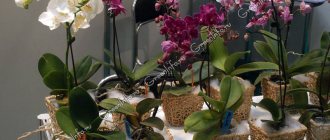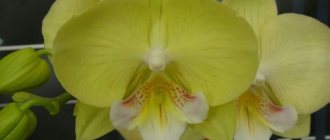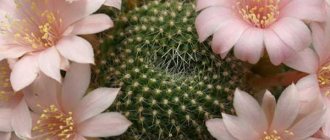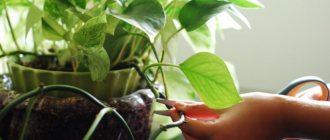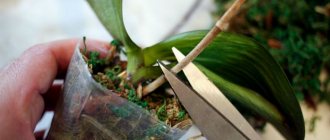Not so long ago, flower growers growing orchids could be counted on one hand. Even in our time, many floriculture lovers are afraid to grow them , as they are frightened by the orchid, as an exotic plant, surrounded since past times by mystery and all sorts of legends.
And only one of the orchid species - phalaenopsis, and especially the hybrid one, has become particularly and quite popular due to the ease of keeping it at home. Next we will tell you about the varieties of phalaenopsis: Charmer, Charming, Equestris, Falstaff.
Detailed description and photo
Phalaenopsis Charmer has yellow flowers that can reach a diameter of 8 cm , with burgundy-red splashes. These inclusions, their color, size and intensity largely depend on the conditions in which the orchid grows.
With proper care, the number of peduncles reaches four arrows, and their height is approximately 60 cm. They branch quite well.
The leaves of this species have an elongated oval shape and a dark green color. They themselves are fleshy and glossy, and their number varies from 3 to 8 pieces. The length of the leaf plates can reach up to 30 cm, and the width - up to 15 cm.
See photos of Phalaenopsis Charmer:
The root thickness is approximately 3-5 mm. The root system is no different from most orchids : fleshy and hollow roots.
Black
Such orchids only visually appear black. In fact, the shade closest to black is provided by special pigments, which can be dark purple, blue or violet.
Black Pearl
Black Pearl. This hybrid variety has unusually shaped flowers. In fact, the color of its buds is purple-burgundy. The lip usually comes in a lighter shade.
Black bird
Black Bird. A very rare and spectacular variety with flowers of a rich blueberry color. They have a dense glossy structure and are located on one peduncle.
Naomi
Naomi. The dark purple color of the petals looks like a large spot in the center of the inflorescence. The edges of the petals are light lilac in color.
How is it different from other orchids?
The characteristic and probably the most important difference between Charmer orchids is their color and color. As mentioned earlier, the flower of this plant has a yellow color with red-burgundy splashes , which become less intense and rare from the center to the periphery of the flower.
If we talk about the differences of this species that are imperceptible at first glance, it is necessary to mention that the flower does not have a specific dormant period, so it can develop all year round. The flowers bloom in turn, starting with those lower on the peduncle.
Since the Charmer orchid itself is a separate species, it has no varieties . No varieties have been released yet. But Charmer as a species belongs to the genus Phalaenopsis, which is represented by many interesting species:
“Big Lip”
This species is distinguished by an unfolded, large middle petal; it is not for nothing that the name of the species is translated as “big lip.”
"Golden"
A distinctive feature of this species is the color of the flower. Varieties belonging to it have yellow (from lemon to gold) flowers.
“Red Lips”
The middle of the flower of such a plant resembles the shape of lips and is colored red or a color close to it . The petals of the flower are white.
"Nice"
It is distinguished by oblong leaves and a long peduncle. The flowers are shaped like butterflies and are white in color.
"Schiller"
The leaves of this orchid have silver stripes and are colored red inside.
"Giant"
From the name it is clear that this plant is distinguished by its size, but it is not the flowers that are gigantic, but the leaves .
“Deer-horned”
This name was given because of the unusual structure of the peduncle, reminiscent of deer antlers. This plant has many thin and long leaves.
Only the most prominent representatives of this genus are listed here; in fact, there are many more of them; intergeneric hybrids also exist.
Subspecies of Equestris orchid
The orchid has several hybrid subspecies:
- Blue. Peduncles are lilac with a blue tint. It has a long flowering period, up to 9 months.
- Alba. Miniature subspecies. The leaves are narrow, the color is white. It also has a long flowering period.
- Grasse. Medium sized flower. Lilac color, oval shape. It is distinguished by a large number of flowers on each peduncle.
There are several more subspecies of this plant, the three presented are the most popular of all.
How much does an adult Phalaenopsis Charmer cost in the store? Where can I buy it?
The price of an adult plant ranges from 1200 rubles to 2000.
The cost depends on the condition of the plant and the pricing policy of the store.
Adult plants are sold in special online stores, in stores with goods for the garden and vegetable garden, there are advertisements on websites for the sale of used things, rarely, but they can be found in hypermarkets.
How to care after flowering is complete
Phalaenopsis needs additional care after it has finished flowering. The peduncle begins to dry out slowly, but it cannot be removed immediately. For some time, the nutrients the plant needs come from the peduncle. There may be this option: immediately after flowering, new buds appear on the peduncle. In this case, you should leave everything as it is, and soon the orchid will again delight you with its delightful flowers.
If this does not happen, the peduncle is cut 1 cm above the bud. Fresh moss is placed around the bud and secured with ropes or other material. The pot is transferred to a stand into which coarse sand must first be poured
It is very important to maintain the appropriate temperature: the room temperature should be around 20-22 degrees. During this period, the flower needs additional sunlight, so the room in which the pot will stand must be bright enough
If everything is done correctly, the orchid will recover faster after flowering.
If you care for your yellow orchid correctly, it will continually delight you with its stunning yellow flowers. Caring for it is not at all difficult, but you must follow all the rules so that the plant remains healthy.
Landing
The first thing you need to take care of is where to plant the flower, i.e. about the potty. When choosing it, do not forget that for the roots to participate in photosynthesis, you need a transparent pot with holes for drainage. The size of the pot should be a couple of centimeters larger than the root part.
The substrate can be purchased in stores designated for this purpose. If we talk about the composition of the soil, it usually contains:
- steamed tree bark;
- charcoal;
- sphagnum moss;
- various inert components.
How to plant correctly:
- Place drainage on the bottom of the pot in a layer of about 1-2 cm.
- Carefully remove the seedling from the container in which it is located. If there are rotten or damaged roots, cut them off and treat the cut area with cinnamon or charcoal powder.
- Spread the roots in a prepared pot with drainage.
- For plant stability, fill the interroot spaces with bark and moss with slight compaction.
Reproduction methods
The easiest way to propagate an orchid is vegetatively (plant parts).
Dividing the bush
This method is used to propagate orchids with a sympodial type of growth (grow in the form of a bush):
- The roots are shaken off the soil mixture;
- The rhizome is divided, two or three pseudobulbs should remain on each part;
- The cut site is treated with crushed activated carbon.
The cuttings are planted in a substrate and placed in a greenhouse.
Children
Small plants - babies - often form in the axils of the leaves or on the peduncle. They need to be planted after the baby has formed roots:
- The baby that has grown in the leaf axil is separated with pruning shears, capturing 1-1.5 cm of tissue from the mother plant, and the cut site is treated;
- The separated plant can be immediately planted in the substrate.
The soil is kept moist.
Cuttings
This method is often used when propagating orchids at home:
- After the end of flowering, the flowering arrow is cut to the very base and cut into pieces of 3-4 cm;
- There should be a dormant bud in the middle of each cutting.
The cuttings are sprinkled with activated carbon at both ends and placed in a greenhouse for germination.
You can also cut off the top of the stem, on which aerial roots have formed, and plant it in prepared soil. Caring for cuttings is the same as caring for an adult plant.
Caring for a plant at home
As for care, the environment is very important for this orchid ; its flowering directly depends on it. The determining factors in this case are temperature, lighting, air humidity and watering:
- The temperature during the day should be maintained within 22°-24°C, at night – 16°-18°C.
- Comfortable air humidity is approximately 40-60%.
- Leaves should not be exposed to direct sunlight, and the light should be diffused.
- It is better to use melt or rain water, as it is softer in structure. You need to water the plant when the walls of the pot become dry.
- Fertilizing can only be done with special fertilizer “For orchids” with every 3-4 waterings.
- During flowering, care generally does not change, but the plant needs additional nutrition.
- Trimming the peduncle after flowering is very simple. It is enough just to identify the dried part of the peduncle, cut it off and then treat the cut with activated carbon or cinnamon.
- Sometimes the plant does not bloom for a long time, to eliminate this problem, make sure that it is properly cared for and maintained. This is the first and main reason.
- To renew flowering, an effective method is to imitate the rainy season. First, you should place the pot with the roots in warm water for three days, and then leave it without watering for 2 weeks.
- Replanting a plant is carried out according to the same algorithm as planting it.
Rooting of children
Under suitable conditions, orchid babies form independently in leaf axils and on peduncles. If the plant cannot cope with this process, then some measures need to be taken to stimulate it. Sudden temperature changes and increased daylight hours will contribute to the birth of babies.
When the first leaves and aerial roots appear on the new formations, they are torn off from the outlet and planted separately. It happens that the baby does not produce roots for a long time, and this has a detrimental effect on the plant. In this case, it must be separated and rooted separately. If you place a container of water nearby, the baby will reach for it and release the roots faster. There are special means to stimulate this process, but they should be used in extreme cases.
Prevention of various problems
The main preventive measure is proper care of the plant and the creation of suitable conditions. also considered effective, but it is important to avoid excess fertilizer .
The Charmer orchid, although it is an unpretentious representative of phalaenopsis, if basic maintenance conditions are not met, it can be affected by parasites and various diseases, and may stop blooming. But if you take a responsible approach to caring for it and create comfortable conditions for it, it will delight you with its “sunny” inflorescences for many years.
Useful video
You can watch the flowering of phalaenopsis and learn tips on growing it in the video:
Find out interesting things about other groups and varieties of phalaenopsis: Big Lip, Golden, Wild Cat, Stone Rose, Kimono, Cleopatra, Legato, Liodoro, Manhattan, Mix, Mini, Multiflora, Narbonne, Parrot, Ravello, Sogo, Surf Song, Frontera, Chengdu , Schiller
Phalaenopsis Charmer is an unpretentious and very beautiful plant with large bright flowers. With proper care, adult specimens can bloom all year round.
Main types of yellow Dendrobiums
Some species of Dendrobium have yellowish petals, which look great in the photo.
- Dendrobium Lindley grows in Southeast Asia and has single-leaf pseudobulbs covered with scale-like leaves. The inflorescences contain up to 14 pale yellow or golden yellow flowers, the diameter of which is up to 5 centimeters. The plant blooms from March to July.
- Lion Dendrobium. This orchid is native to Cambodia, Kalimantan and Laos. The plant is small, has triangular leaves and peduncles with creamy yellow flowers about 2 centimeters in diameter. The orchid blooms mainly in summer and autumn.
Reproduction methods
There are two methods of propagation - seed and using sprouts.
The first method is ineffective, because it is very difficult to create a special environment for sowing at home. The seeds are small, like dust, and it is difficult to take root if the germination technique is disrupted. It is usually practiced in laboratory conditions.
The second option is more effective and justified.
Flowers over 3 years old produce babies (take those that grow in the upper part of the shoot, as the lower ones have poor survival rate). They are separated together with the stem so that the bottom and top are 2-3 cm long.
The plant does not reproduce easily
The cut areas are sprinkled with charcoal. Then they are immersed in one of the root growth stimulators for half an hour.
- The sprouts are planted in a nutrient substrate of steamed crushed pine bark, charcoal and sphagnum moss. As a planting container, you can use 100 ml plastic cups with holes in the bottom.
- The seedlings are irrigated with a spray bottle and placed in a warm and well-lit place.
For quick rooting, they can be covered with a transparent film. As soon as they begin to form new buds, the shelter is removed.
After 3-4 roots appear, they are transplanted into a plastic or ceramic pot slightly larger than the size of the roots.
